
The LONDON TRANSPORT G classThis page created 17th March 1999, updated 1st August 2020 by Ian SmithThe Guy Arab Mark IThe first of the Guy Arabs came to London Transport in August 1942. It had the new Guy Arab chassis, with a paltry Gardner 5LW diesel engine producing just 85hp to lug the 7ton 13cwt ensemble around. Drive was through a manually operated crash gearbox mounted halfway along the bus, where preselector gearboxes usually went. This meant that the gear shift linkage produced an inverted gate, something else for the drivers to get used to. At least the engine was rubber-mounted, unlike the Bristols. Electrics were 24 volt.After the first ten the remainder had smaller fuel tanks, helping to reduce the weight. These were designated 1/2G2. 2G2: Park Royal, G1-31, 51-71 (Total 52)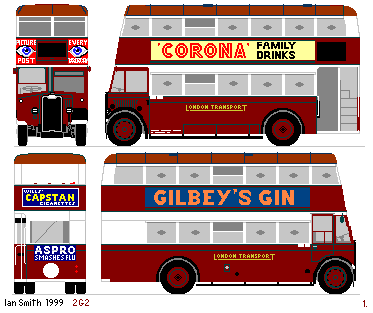 The bodywork on the first was by Park Royal,
the same design as used for the Leyland STDs and the Bristol 1B1s.
Capturing the spirit of the times, these were classified 2G2 (not 1G1).
They were delivered with soppy weak sidelight mounts, no side display,
no antishatter netting and only primer paint.
They went in to Chiswick (the old tram depot)
to have a side blind aperture and apparatus fitted,
and to receive the odd wartime sidelights with their minuscule apertures.
The livery was the wartime version of the 1933 livery, with variations:
the roof was red lead brown rather than silver, as an air-raid precaution,
and the black lining was absent.
The cast-iron radiator was painted black,
with a white cheat-line and white GUY lettering on some.
White trims to mudguards and the rear, and around the doorway,
were further efforts to assist in the blackout.
The main livery was red and white - for the first four!
After that the supply of red pigment ran out, and the buses emerged in Indian Red and white,
the "Indian Red" being the colour previously prescribed for wheels.
In most cases they retained this colour until the first post-war overhaul
The bodywork on the first was by Park Royal,
the same design as used for the Leyland STDs and the Bristol 1B1s.
Capturing the spirit of the times, these were classified 2G2 (not 1G1).
They were delivered with soppy weak sidelight mounts, no side display,
no antishatter netting and only primer paint.
They went in to Chiswick (the old tram depot)
to have a side blind aperture and apparatus fitted,
and to receive the odd wartime sidelights with their minuscule apertures.
The livery was the wartime version of the 1933 livery, with variations:
the roof was red lead brown rather than silver, as an air-raid precaution,
and the black lining was absent.
The cast-iron radiator was painted black,
with a white cheat-line and white GUY lettering on some.
White trims to mudguards and the rear, and around the doorway,
were further efforts to assist in the blackout.
The main livery was red and white - for the first four!
After that the supply of red pigment ran out, and the buses emerged in Indian Red and white,
the "Indian Red" being the colour previously prescribed for wheels.
In most cases they retained this colour until the first post-war overhaul
Most of them were delivered with a plain steel emergency exit, but the last nine had a glazed version. These were retrofitted to the others as materials allowed, usually at the first post-war overhaul, although some were never modified.
Into serviceThe much needed buses dribbled off the production lines in late 1942 and early 1943, passed through Chiswick modifications, then went to a varity of locations over several months, while a series of chassis modifications and then brake modifications were installed. Some were done at Chiswick, some at Tottenham, but also at Putney Bridge, Romford and Luton! Although this was to ensure that the early bugs in the chassis design were ironed out before intensive service use, the delay in getting them into service cannot have endeared London Transport to the Ministry of War Transport, who probably cast a more jaundiced eye on LT's claims to be desperate for buses in the following two years! Although G1 was licensed in December 1942, followed by a few others, most were withdrawn into store for modifications and it was June 1943 before serious service began, from Tottenham (AR) and Hanwell (HW). These garages were among the few with doors tall enough to enter the 14ft 6in high buses. Later users of this batch included Alperton (ON), Barking (BK), Upton Park (U) and latterly Hornchurch (RD).The Alperton buses became a discrete set when their electrical systems were modified towards the end of 1947, fitting heating coils to aid in starting, making these 2/2G2s. G13 at Hornchurch was the only Arab I to receive the new all-red with cream band livery at overhaul in 1951. Arab Mk1 main routes
1/2G3: Weymann, G32-42, 44-50, (total 18)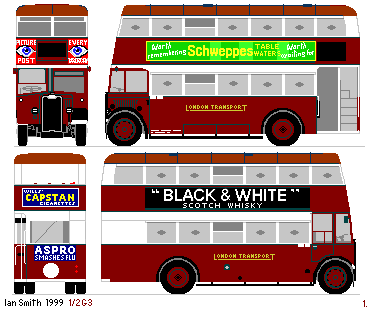 The first batch of Weymann-bodied Guys was built at the same time as the first lot from Park Royal.
They were very similar, but with small recognition points for the cognoscenti
(of whom there were few during the war, Italy starting off on the "other" side)
The main difference was that the rake of the front dissolved into the cab front
rather than making the abrupt transition of the Park royals.
The main side panels were single pieces below the windows too,
avoiding the bodyside moulding and giving these buses a more modern look.
On the other hand, they were squarer in plan, with very little rake in at the front,
so the upper deck vents were narrower than the windows,
and the roof had single corner joints rather than the doubles of the Park Royals.
The first batch of Weymann-bodied Guys was built at the same time as the first lot from Park Royal.
They were very similar, but with small recognition points for the cognoscenti
(of whom there were few during the war, Italy starting off on the "other" side)
The main difference was that the rake of the front dissolved into the cab front
rather than making the abrupt transition of the Park royals.
The main side panels were single pieces below the windows too,
avoiding the bodyside moulding and giving these buses a more modern look.
On the other hand, they were squarer in plan, with very little rake in at the front,
so the upper deck vents were narrower than the windows,
and the roof had single corner joints rather than the doubles of the Park Royals.
The Weymanns too were delivered without side route displays and with soppy sidelights. These were fitted at Chiswick before painting. The first eleven, dribbling into Chiswick in late 1942 and early 1943, received brown and white livery, but the latter seven, in spring 1943 received proper red paint. They went for service at Tottenham and Hanwell alongside the other Mk Is, and presently were found at Alperton and Upton Park, and latterly Barking. After the war they too received modifications: more windows; strengthened bulkheads; glazed emergency exits (but not all); rear number-plate and lights; red and white paint. The two at Alperton (G34 and G50) received the electrical changes to become 2/2G3 Eight were demoted to training duties, but one (G41) was rescued from this to spend most of 1951 in service at Hornchurch. Meanwhile others were being forcibly delicensed by the men from the ministry, the soft wood used for their framing succumbing to rot. 1951 saw their end of passenger service. Some went directly to Chiswick for decommissioning and sale, others to a variety of storage sites: Edgware had a large open-air space, Poplar, Bow and Fulwell were tall enough, being trolleybus depots, and Stansted Airfield was used for a while. Most were sold either to Cohens for scrap, or to W.North in Leeds for foreign or non-psv sale. Some went to Yugoslavia, and a few to Gran Canaria. 1/2G4: Duple, G43, (total 1)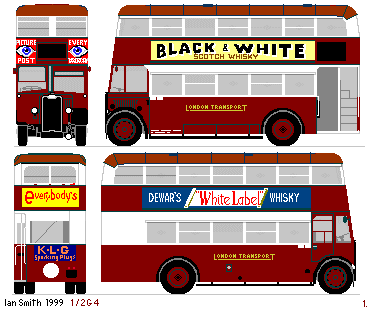 The other Arab I, G43, was bodied by Duple,
not a normal London Transport supplier
but was third on their list of requested suppliers due to its location in Hendon.
It was a one-off allocation for building, but unlike others it was not swapped
for a Park Royal or Weymann product.
It arrived at Chiswick in primer paint during January 1943, for fitting with a side blind and sturdier sidelights,
and was painted brown and white. Then it was stored at Putney Bridge until allocated for service at Hanwell from July 1943.
It moved east to Upton Park in January 1946, displaced by the
second batch of Bristols.
The other Arab I, G43, was bodied by Duple,
not a normal London Transport supplier
but was third on their list of requested suppliers due to its location in Hendon.
It was a one-off allocation for building, but unlike others it was not swapped
for a Park Royal or Weymann product.
It arrived at Chiswick in primer paint during January 1943, for fitting with a side blind and sturdier sidelights,
and was painted brown and white. Then it was stored at Putney Bridge until allocated for service at Hanwell from July 1943.
It moved east to Upton Park in January 1946, displaced by the
second batch of Bristols.
Whilst there it received more opening windows and a red/white paint job. The unique Duple body could be recognised at a distance by its broad central pillar between the front upper windows. It had no white above the cab, as the windows and door stretched very high. Conversely there was a broad white strip below the saloon windows. The panelling was plain, with very little beading. The roof had external framing like the Park Royals and Weymanns, but incorporated a more pronounced "lobster-back" that cut the corner off the rear windows but saved on skilled panel-beaters needed to produce conventional domes. The emergency exit was glazed from the beginning.
G43 was withdrawn from Upton Park when displaced by STLs in November 1951,
and formed one of the large batch of Guys shipped to Sarajevo (Yugoslavia) in early 1952.
1/2G7: Northern Coachbuilders, G30, (total 1)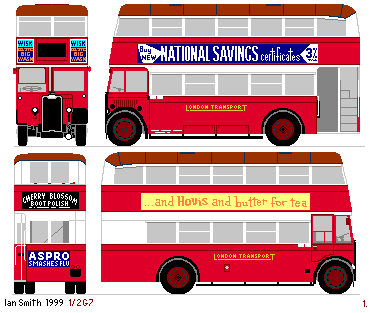 Yes: G30 was one of the original Park Royal batch, mentioned above.
But it suffered a dire close encounter with a cruise missile on 23rd June 1944.
This destroyed the body beyond all hope of repair, but left a salvageable chassis.
This too might have been dismantled for spares, but the Ministry decreed that it should be rebodied.
The builder allocated was Northern Coachbuilders at Cramlington, Northumberland.
They produced another unique body for G30.
Yes: G30 was one of the original Park Royal batch, mentioned above.
But it suffered a dire close encounter with a cruise missile on 23rd June 1944.
This destroyed the body beyond all hope of repair, but left a salvageable chassis.
This too might have been dismantled for spares, but the Ministry decreed that it should be rebodied.
The builder allocated was Northern Coachbuilders at Cramlington, Northumberland.
They produced another unique body for G30.
Instant recognition points included the overhang of the top deck above the cab; narrow twin windows at the rear, both top and bottom; a lobster-back; a level top and bottom to the front saloon windows - and the windscreen; double beading on both decks; roof ribbing INSIDE the roof rather than outside. The rebuilt bus arrived back at Chiswick in January 1945, was painted red and white
but did not receive side destination gear.
It was allocated to Alperton (never Tottenham again)
and lasted until the Guys went from Alperton in July 1952.
It then via Norths of Leeds to Ceylon, to the South Western Omnibus Co.
|
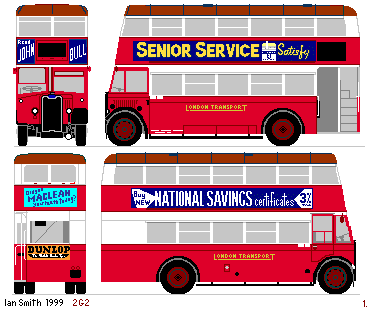
 Bus Stop
Bus Stop Contents.
Contents. Guy Arab II
Guy Arab II